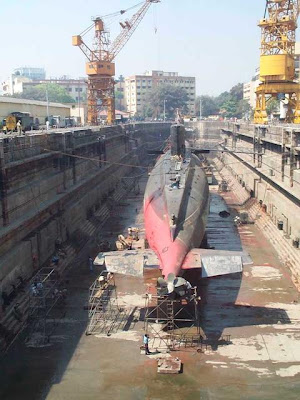 An Indian Navy Kilo class diesel electric submarine under repair at Mazagon Docks, Mumbai.
An Indian Navy Kilo class diesel electric submarine under repair at Mazagon Docks, Mumbai.-
Most countries bordering the Indian Ocean remain fairly silent about their submarine services, but, as indicated by the following India has openly described ongoing deficiencies:
"Kobus" at Naval Open Source Intelligence located the following article. January 13, 2009 IBN Live reported:
"New Delhi: Over-emphasis on indigenous work is hurting India's readiness for war.
As India's vital submarine arm struggles with dangerously low numbers, a top-end submarine has been taken out of the fleet for a repair programme.
As India's vital submarine arm struggles with dangerously low numbers, a top-end submarine has been taken out of the fleet for a repair programme.
The shocking part is that the repair schedule will last 10 years. Such upgrades have previously been done overseas in two years. One could compare this to a submarine being laid comatose, at least in the case of the INS Sindhukirti, a frontline Kilo class attack submarine of the Indian Navy.
It's been in dry dock at Vizag for a refit programme for close to five years now. It seems that Hindustan Shipyards, the government-owned contractor with little experience in submarine upgrades, will take at least another five years before the submarine can be put to water again.
Unavailable to the submarine-starved Navy for 10 of the 30 years of its useful life, the Sindhukirti is as good as a write off.
"How viable is a surgery which requires a healthy patient to be in a hospital bed for one-third of his life? That is the approximate analogy for the mid-life upgrade for this submarine INS Sindhukirti, the Dry Dock Queen. Four submarines are stuck in such protracted upgrades. Not surprisingly, just nobody is accountable," said our defence correspondent.
Russia took just two years each to upgrade six similar Kilo class submarines for the Indian Navy.
The government insists that it is now building national capability with inhouse upgrades.
"That kind of expertise did not exist in India before and this is for the first time that we are trying it out here. Instead of sending them to Russia all the way, this one is being offloaded to Hindustan Shipyards. There are some problems in their procurement procedures. It takes a little longer than is expected," said Chief of Naval Staff, Admiral Suresh Mehta.
What this trade-off on time does to India's military readiness is anybody's guess. It took a recent [ Comptroller and Auditor General of India] CAG report to blow the lid of the Indian Navy's worst kept secret: that the vital submarine arm faces a crisis of numbers.
The shocking revelations of the report were:
- Only seven of India's 16 submarines are available for combat at any time.
- 10 of these 16 ageing submarines will be due for phase-out by 2012.
- To maintain current numbers, one submarine needs to be inducted every two years but there's been no addition since 2001.
- India's only submarine-making facility in Mumbai was kept idle for 12 years.
- The gaping hole in India's naval capability is showing."
PointSingularity86 reported earlier on this issue in his blog here .
-
Similar delays in upgrades have haunted Australia's Collins Class Submarine program and perhaps for the same reasons. While indigenous construction and upgrades promote self sufficiency and national security they inevitably involve a lengthy learning curve denotes inefficiency, high extra costs and extended "down time" for individual subs.
-
Pete










